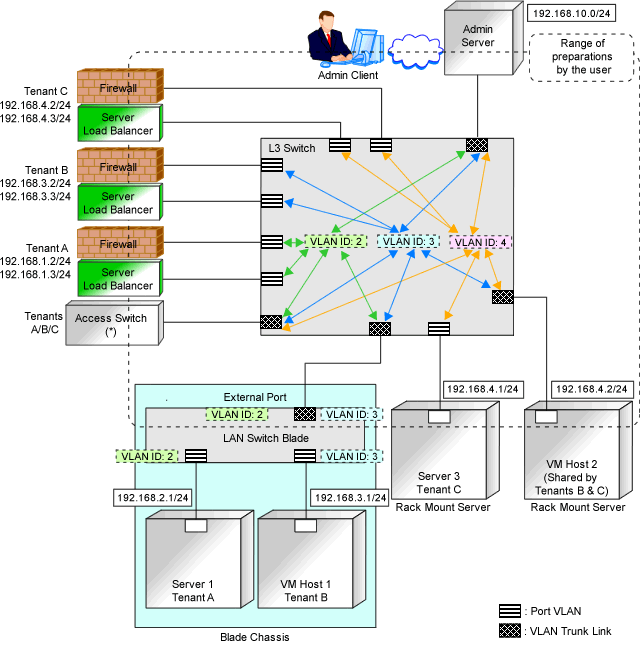Define the information to be configured on each unmanaged network device.
Figure 9.12 Example of the Configuration Scope of Unmanaged Network Devices

* Note: L2 switches or Ethernet fabric switches.
Define the public LAN settings that must be pre-configured by users.
Routing Information
Define the routing method for the routers and center switches to enable communication with the L-Platform network.
VLAN information
Check the VLAN information of routers and center switches used within the L-Platform network, and then define the VLAN information necessary for connection and communication with L-Platforms.
Redundancy information
Check whether to make network devices and communication routes redundant, and then define any settings necessary for redundant configuration.
Define the admin LAN settings that must be pre-configured by users.
Figure 9.13 Admin LAN Network Configuration

* Note: L2 switches or Ethernet fabric switches.
Routing Information
When the admin server and individual devices (servers, storage units, network devices, and admin clients) belong to different subnets, define the routing method on the L3 switch to enable communication between the admin server and individual devices using the admin LAN.
When using routing protocols (such as RIP and OSFP), define the information necessary for configuring dynamic routing. When not using dynamic routing, define the settings for the routing information table.
In addition, it is necessary to configure the following multicast routing for managed resources from the admin server.
225.1.0.1 - 225.1.0.8 |
VLAN information
Check the VLAN information of external ports of LAN switch blades and L3 switches used in the admin LAN network, and define the settings (VLAN IDs). Set the ports to be used as trunk links when necessary.
Redundancy information
Check whether to make network devices and communication routes redundant, and then define any settings necessary for redundant configuration.
Access control information
When configuring access control on L3 switches, define the ports that allow connection, because it is necessary to allow connection with the ports used by Resource Orchestrator.
Refer to "Appendix A Port List", for details on the ports used by Resource Orchestrator.
Define whether to allow or block communication when the routing is operating in order to define the access control.
When using the following functions, it is necessary to configure DHCP relay agents to enable the manager to receive DHCP requests from managed servers belonging to different subnets.
Backup and restoration of managed servers
Collection and deployment of cloning images
SAN boot using HBA address rename
When specifying the IP address of the DHCP server during registration of ISM coordination, it is also necessary to configure DHCP relay agents for the DHCP server.
When using the HBA address rename setup service, it is necessary to configure DHCP relay agents to enable the HBA address rename setup service to receive DHCP requests from managed servers belonging to different subnets.
For information about multicast routing setting and DHCP relay agents, refer to the router manual.